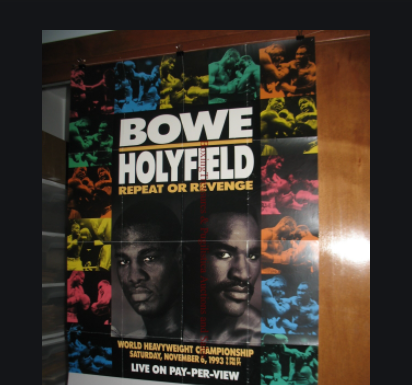Featured Articles
Evander Holyfield’s Las Vegas Episodes: A Walk Down Memory Lane

PART ONE OF A TWO-PART STORY. Evander Holyfield made his pro debut at Madison Square Garden in 1984 and had his final fight at a concert hall in Copenhagen, Denmark, in 2011. In the interim he had 55 fights, 17 in Las Vegas.
Many of his most celebrated triumphs happened in Las Vegas, but looking back Evander was only 6-6 in his last dozen Las Vegas engagements, including his only two losses by stoppage — food for thought for anyone that would welcome Evander back into the ring at his advanced age (he’s 58).
Holyfield’s third Las Vegas fight was a rip-snorter with Michael Dokes in the sports pavilion at Caesars Palace. It was Holyfield’s third fight since leaving the cruiserweight ranks. “He made me reach down deep inside,” said Holyfield after stopping Dokes in the 10th.
Holyfield won the unified heavyweight title on his next visit to Las Vegas with a third-round, one-punch knockout of poorly-conditioned Buster Douglas at Steve Wynn’s Mirage. Twenty-six months later, after a hard tussle with George Foreman in Atlantic City and a seventh-round stoppage of late sub Bert Cooper in Atlanta, Holyfield was back in Las Vegas at Caesars Palace where he successfully defended his belts with a unanimous decision over a well-past-his-prime Larry Holmes who won a few rounds but was never a threat.
That prefaced the first of his three fights with Riddick Bowe. The first meeting was the most entertaining. In fact, Bowe-Holyfield I was named The Ring magazine Fight of the Year.
It was an accolade unsupported by the numbers. Bowe was the busier man and was credited with out-landing Evander 357-242. The judges had him winning by margins of 7, 7, and 3 points. (But, yes, it was a terrific fight, certainly one of the best of all time as far as undiluted heavyweight title fights are concerned.)
After the fight, an exhausted Holyfield was asked if he wanted a rematch. “No,” he said, I think I’m finished.” But a rematch was inevitable.
After out-pointing Alex Stewart in an intervening fight, Holyfield caught up with Bowe again. They met in the outdoor arena at Caesars Palace on Nov. 6, 1993, 51 weeks after their first encounter.
All who were there will never forget it, but what they remember is the unscheduled intermission. The bout was held up for 21 minutes in the seventh round when “Fan Man” James Miller paraglided into the ring. The scene was surreal beyond description. (“The Chute Hits The Fan” read the front-page headline in the next day’s New York Daily News.)
Bowe-Holyfield II wasn’t as violent as the first meeting. The match was tilting Evander’s way before the break and he held on to win a majority decision. The Associated Press correspondent scored the fight 8-4 for Riddick Bowe, but he had an off night. Neither Bowe nor his salty manager Rock Newman quibbled with the verdict.
Holyfield’s first defense in his second reign as heavyweight champion took place at Caesars Palace. The man in the opposite corner was undefeated (34-0) Michael Moorer. A former light heavyweight champion who leapfrogged the cruiserweight division, Moorer was a KO artist, but against Evander in what was his second fight with new trainer Teddy Atlas, he fought with great composure and became the first southpaw to win a world heavyweight title. It was a majority decision that virtually everyone thought should have been unanimous.
After the fight, Holyfield went to the hospital where he was treated for severe dehydration and a tear in his left shoulder. When he returned to his home in Atlanta, he had a more thorough check-up by doctors who determined that the 31-year-old boxer had a congenital heart defect, a faulty left ventricle that wasn’t pumping sufficient oxygen to his organs and tissues. The condition, said his personal physician, wasn’t life-threatening “as long as he assumes a less strenuous lifestyle.”
This information was relayed to the press four days after his loss to Moorer at a news conference at Atlanta’s Crawford Long Hospital. After walking slowly to the podium, accompanied by a nurse, Holyfield said, “I am going to miss boxing, but life is more important.”
“It is ironic,” said boxing promoter Dan Duva, “that what people will remember about Evander is that he had the biggest heart in boxing.”
Evander Holyfield left the sport with a 30-2 record. It was speculated that with his competitive fire, he just might carve out a successful career in a sport like bowling. But hold the phone.
Check out more boxing news on video at the Boxing Channel
To comment on this story in the Fight Forum CLICK HERE
-

 Featured Articles4 weeks ago
Featured Articles4 weeks agoAvila Perspective, Chap. 330: Matchroom in New York plus the Latest on Canelo-Crawford
-

 Featured Articles3 weeks ago
Featured Articles3 weeks agoVito Mielnicki Jr Whitewashes Kamil Gardzielik Before the Home Folks in Newark
-

 Featured Articles8 hours ago
Featured Articles8 hours agoResults and Recaps from New York Where Taylor Edged Serrano Once Again
-

 Featured Articles4 weeks ago
Featured Articles4 weeks agoCatching Up with Clay Moyle Who Talks About His Massive Collection of Boxing Books
-

 Featured Articles5 days ago
Featured Articles5 days agoFrom a Sympathetic Figure to a Pariah: The Travails of Julio Cesar Chavez Jr
-

 Featured Articles3 weeks ago
Featured Articles3 weeks agoMore Medals for Hawaii’s Patricio Family at the USA Boxing Summer Festival
-

 Featured Articles7 days ago
Featured Articles7 days agoCatterall vs Eubank Ends Prematurely; Catterall Wins a Technical Decision
-

 Featured Articles4 weeks ago
Featured Articles4 weeks agoRichardson Hitchins Batters and Stops George Kambosos at Madison Square Garden




















